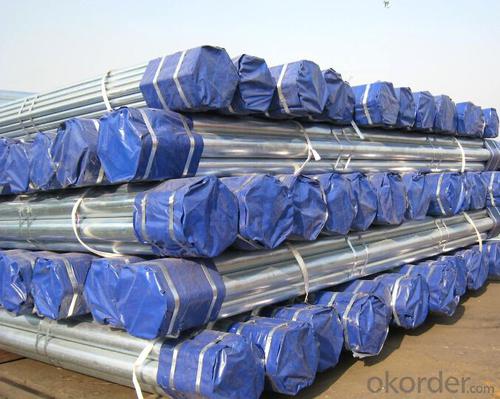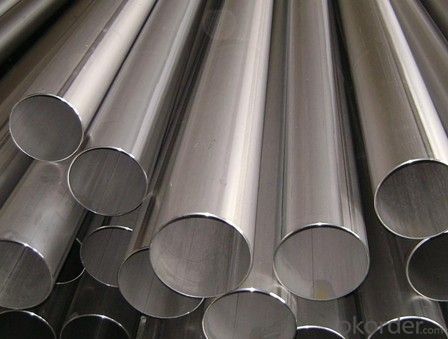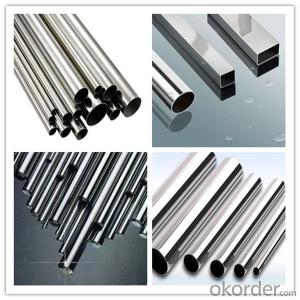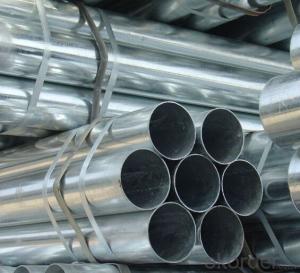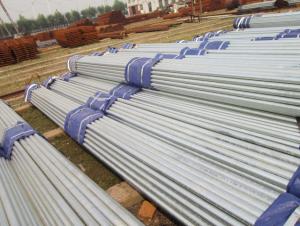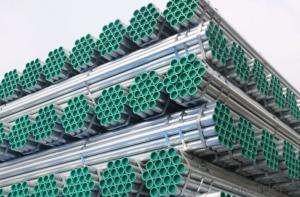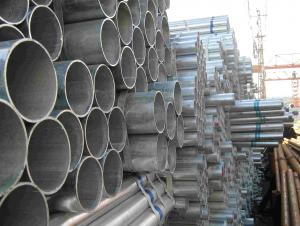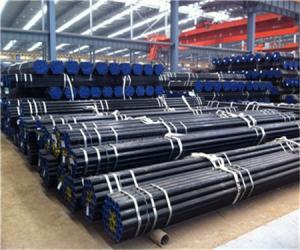Galvanized Stainless Steel Pipes With Good Price
- Loading Port:
- China main port
- Payment Terms:
- TT or LC
- Min Order Qty:
- 100 m.t.
- Supply Capability:
- 10000 m.t./month
OKorder Service Pledge
OKorder Financial Service
You Might Also Like
1、Structure of Seamless Pipe :
Seamless pipe is formed by drawing a solid billet over a piercing rod to create the hollow shell, so it is regarded as withstanding pressure better than other types, and is often more easily available than welded pipe.
2、Main Features of the Seamless Pipe :
• Good visual effect
• Reasonable price
• High manufacturing accuracy
• High strength
• Small inertia resistance
• Strong heat dissipation ability
3、Seamless Pipe Specification:
1) Material:20#(ASTM A 106/A53 GRB.API5LGRB,GB),45#,16Mn,10#.
2) Specification range:OD:21.3-610mm,WT:6-70mm,length:6-12m or according to the requirement of clients.
3) Excutive standards:GB,ASME API5L.ASTM A 106/A53,Despite of the above standards,we can also supply seamless steel pipe with standard of DIN,JIS,and so on,and also develop new products according to the requirements of our clients!
4) Surface:black lacquered,varnish coating or galvanized.
5) Ends:Beveled or square cut,plastic capped,painted.
6) Packing:bundles wrapped with strong steel strip,seaworthy packing.
4、Packaging & Delivery
Packaging Details: | seaworthy package,bundles wrapped with strong steel strip |
Delivery Detail: | 15-30days after received 30%TT |
5、FAQ of Seamless Pipe :
①How is the quality of your products?
If you want see our quality certifications and all kinds of testing report, please just ask us for it.
Guaranteed: If products’ quality don’t accord to discription as we give or the promise before you place order, we promise 100% refund.
②How about price?
We quote as lowest as possible for any customer, and discount can be given according to quantity”,if you like bargain and factory price is not low enough as you think, just don’t waste your time.Please trust the quotation we would give you, it is professional one.
③Why should you chose us?
Our service formula: good quality+good price+good service=customer’s trust
SGS test is available, customer inspection before shipping is welcome, third party inspection is no problem.
Any question, pls feel free to contact us !
6、Seamless Pipe Images
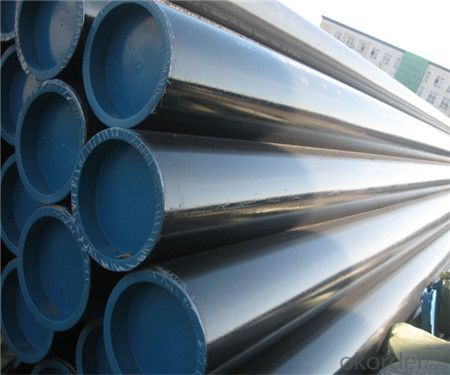

- Q: What are the disadvantages of using stainless steel pipes?
- Although stainless steel pipes offer a multitude of advantages, it is crucial to take into account a few drawbacks: 1. Cost: Stainless steel pipes are typically more expensive than alternative pipe materials such as PVC or carbon steel. This increased cost can impact the overall project budget. 2. Limitations in Corrosion Resistance: Despite its reputation for corrosion resistance, stainless steel is not entirely impervious to corrosion. In certain environments, like highly acidic or alkaline conditions, stainless steel pipes can still corrode over time. 3. Brittle Nature: Stainless steel pipes possess a greater tendency to become brittle compared to other materials. This makes them more prone to cracking or breaking under extreme temperatures or stress. This can be problematic in applications where the pipes are subjected to significant pressure or thermal fluctuations. 4. Difficulty in Modification: In comparison to alternative pipe materials, modifying or altering installed stainless steel pipes is more challenging. This can pose a problem if any changes or adjustments need to be made in the future, as it may require additional time and effort. 5. Heat Conductivity: Stainless steel has lower heat conductivity in comparison to materials such as copper. As a result, stainless steel pipes may not efficiently transfer heat, which can be a disadvantage in applications where heat transfer is crucial. In conclusion, while stainless steel pipes offer numerous benefits, it is crucial to consider these disadvantages when selecting the appropriate material for a specific project.
- Q: What is the difference between 316 and 316LN stainless steel pipes?
- 316 and 316LN stainless steel pipes are both variations of the same grade of stainless steel, which is known as 316. However, there are some differences between the two. The main difference between 316 and 316LN stainless steel pipes lies in their nitrogen content. 316LN stainless steel contains a higher amount of nitrogen compared to 316 stainless steel. The addition of nitrogen improves the strength and corrosion resistance of the material, making it more suitable for certain applications. Due to its increased nitrogen content, 316LN stainless steel pipes exhibit improved resistance to pitting and crevice corrosion, especially in chloride environments. This makes them particularly suitable for use in marine environments or other applications where the pipes may come into contact with corrosive substances. Another difference between the two grades is their availability and cost. 316 stainless steel pipes are more widely available and commonly used, making them generally more cost-effective compared to 316LN stainless steel pipes. However, 316LN stainless steel pipes may be required for specific applications where enhanced corrosion resistance is necessary. In summary, the main difference between 316 and 316LN stainless steel pipes lies in their nitrogen content, which affects their corrosion resistance properties. While 316 stainless steel is more widely available and cost-effective, 316LN stainless steel offers improved resistance to pitting and crevice corrosion, making it suitable for certain applications.
- Q: What is the difference between 304H and 304L stainless steel pipes?
- The carbon content is the main distinction between 304H and 304L stainless steel pipes. 304H pipes contain a higher carbon content, typically ranging from 0.04-0.10%, making them ideal for high-temperature uses. This increased carbon content enhances their strength and resistance to sensitization, which is the creation of chromium carbides at grain boundaries, resulting in reduced corrosion resistance. On the flip side, 304L stainless steel pipes possess a lower carbon content, usually around 0.03%, making them more appropriate for welding purposes. The reduced carbon content helps minimize the formation of chromium carbides, thereby lowering the risk of sensitization during welding. As a result, corrosion resistance is improved, and weldability is enhanced. To summarize, albeit both 304H and 304L stainless steel pipes are variations of the 304 grade, their distinction lies in their carbon content. 304H pipes are favored for high-temperature applications due to their higher carbon content and improved high-temperature strength, while 304L pipes are better suited for welding applications due to their lower carbon content and enhanced weldability.
- Q: Can stainless steel pipes be used for food processing applications?
- Yes, stainless steel pipes can be used for food processing applications. Stainless steel is a highly corrosion-resistant material that is non-reactive and does not impart any taste or odor to the food being processed. It is also easy to clean and maintain, making it a suitable choice for ensuring food safety and hygiene in processing environments.
- Q: What is the difference between a pipe and a tube in stainless steel applications?
- The main difference between a pipe and a tube in stainless steel applications is their dimensions and manufacturing processes. Pipes are typically used to transport fluids or gases and have standardized dimensions, with specific wall thicknesses and outside diameters. Tubes, on the other hand, have a wide range of dimensions and are often used for structural or mechanical applications. Tubes can have varying wall thicknesses and outside diameters, providing more flexibility in design and functionality. Additionally, the manufacturing processes for pipes and tubes differ. Pipes are typically manufactured through a welding or seamless process, while tubes can be produced through various methods such as welding, seamless, or extrusion.
- Q: What are the different types of stainless steel pipe insulation?
- On the market, you can find various stainless steel pipe insulation options. These options differ in terms of their material composition, construction, and insulation properties. One popular option is fiberglass insulation, which involves wrapping a layer of fiberglass material around the stainless steel pipe. This type of insulation is known for its exceptional thermal insulation properties and its ability to withstand high temperatures. It is also resistant to moisture, making it suitable for both indoor and outdoor use. Another option is foam insulation, which is made from a foamed plastic material like polyurethane or polystyrene. Foam insulation is lightweight, easy to install, and provides good thermal and acoustic insulation. It is commonly used in residential and commercial buildings to insulate hot water pipes and HVAC systems. Additionally, there are elastomeric insulation materials, which are flexible rubber-like materials that can be easily wrapped around the stainless steel pipe. These materials are recognized for their excellent thermal insulation properties and their ability to resist moisture and condensation. Elastomeric insulation is frequently used in refrigeration and air conditioning systems. Lastly, there are pre-insulated stainless steel pipe systems, which come with a layer of insulation material already applied to the stainless steel pipe. This type of insulation is commonly used in industrial applications where thermal insulation is critical, such as in chemical plants or oil refineries. To sum up, the available options for stainless steel pipe insulation include fiberglass insulation, foam insulation, elastomeric insulation, and pre-insulated pipe systems. The choice of insulation type depends on factors such as the specific application, desired insulation properties, and budget.
- Q: Can stainless steel pipes be used for hydraulic systems?
- Yes, stainless steel pipes can be used for hydraulic systems. Stainless steel is a highly durable and corrosion-resistant material, which makes it suitable for use in hydraulic systems. It is capable of withstanding high pressure and extreme temperatures, making it a reliable choice for hydraulic applications. Stainless steel pipes also have excellent resistance to chemical and environmental factors, ensuring the longevity and reliability of the hydraulic system. Furthermore, stainless steel pipes offer excellent dimensional stability, which is crucial for maintaining the integrity and efficiency of the hydraulic system. Overall, stainless steel pipes are a popular choice for hydraulic systems due to their durability, corrosion resistance, and high performance capabilities.
- Q: Can stainless steel pipes be used for desalination plants?
- Yes, stainless steel pipes can be used for desalination plants. Stainless steel is a highly corrosion-resistant material, which makes it suitable for use in desalination plants where the water contains high levels of salt and other corrosive substances. The high corrosion resistance of stainless steel pipes helps to prevent the buildup of scale and the formation of rust, ensuring the longevity and efficiency of the desalination plant. Additionally, stainless steel pipes are also known for their high strength and durability, which can withstand the high pressure and temperature conditions often found in desalination plants. Overall, stainless steel pipes are an ideal choice for desalination plants due to their corrosion resistance, strength, and durability.
- Q: 310 stainless steel resistance to high temperature?
- American brand 310S, also known as 2520, used in high temperature furnace tube manufacturingMain features: austenitic stainless steel
- Q: Are stainless steel pipes suitable for nuclear power plants?
- Indeed, stainless steel pipes are indeed a fitting choice for nuclear power plants. Owing to their remarkable resistance to corrosion, impressive strength, and capability to endure extreme temperatures and pressures, stainless steel has gained widespread utilization in nuclear power plants. These pipes serve various functions within the nuclear power plant, such as transporting coolant, steam, and other fluids. The resistance of stainless steel pipes to corrosion is of utmost importance in averting leaks and preserving the integrity of the system. Moreover, stainless steel also exhibits resistance to radiation damage, rendering it a fitting substance for applications in nuclear power plants.
Send your message to us
Galvanized Stainless Steel Pipes With Good Price
- Loading Port:
- China main port
- Payment Terms:
- TT or LC
- Min Order Qty:
- 100 m.t.
- Supply Capability:
- 10000 m.t./month
OKorder Service Pledge
OKorder Financial Service
Similar products
Hot products
Hot Searches
Related keywords



